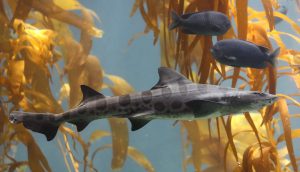
On beautiful, clear days here on Catalina Island, taking a stroll down the pier is the perfect way to spot our elusive friend, the leopard shark! These shy guys love to hang out in Catalina’s shallow coves and search the sand for benthic, or bottom dwelling critters like crabs, shrimp, and rockfish. If you’ve visited CIMI before, than you may have been lucky enough to have spotted one of these striped guys from the pier, or maybe even caught a glimpse on a snorkel!

Leopard sharks have long fascinated us with their mysterious behavior; Just as fast as they congregate in our coves, they are gone hours later. It is hard to know precisely when we will see them gliding under the pier, however they usually enjoy cruising just outside the surf zone during the day, and move to deeper waters at night. They move with quiet agility, but are spooked easily and don’t much enjoy human swimming companions. This shy behavior makes them a very non-threatening species to us, as they have never been known to act aggressively.
 Leopard sharks inhabit the shallow waters of the North Pacific, ranging from Oregon to Mexico. These sharks don’t usually travel far, which has caused genetic diversity to occur within the isolated populations. Some populations grow bigger than the average mature size of about 4 feet, and others produce less offspring than the average. They don’t really like water temperatures that drop below about 50 degrees Fahrenheit, and one study recorded a tagged individual traveling about 87 miles south to escape the colder Northern California waters. Talk about cold feet, or fins in this case!
Leopard sharks inhabit the shallow waters of the North Pacific, ranging from Oregon to Mexico. These sharks don’t usually travel far, which has caused genetic diversity to occur within the isolated populations. Some populations grow bigger than the average mature size of about 4 feet, and others produce less offspring than the average. They don’t really like water temperatures that drop below about 50 degrees Fahrenheit, and one study recorded a tagged individual traveling about 87 miles south to escape the colder Northern California waters. Talk about cold feet, or fins in this case!
 Leopard sharks are viviparous, which is a fancy way of saying they give live birth. Leopard moms like to give birth in very shallow areas, sometimes as shallow as 3 feet, where their dorsal fins might even be exposed. They give birth to anywhere from 7 to 37 pups, which will remain in even shallower areas for their early lives.
Leopard sharks are viviparous, which is a fancy way of saying they give live birth. Leopard moms like to give birth in very shallow areas, sometimes as shallow as 3 feet, where their dorsal fins might even be exposed. They give birth to anywhere from 7 to 37 pups, which will remain in even shallower areas for their early lives.
These patterned beauties are quite the sight to see in the water, but since they enjoy shallow areas, they are vulnerable to human pollution. They get themselves into trouble when they swim around warm water outputs coming from power plants. Leopard sharks are exposed to pesticides and other harmful runoff from agricultural areas, due to the nature of their shallow environments. They are also susceptible to being caught in gillnets, long lines, and other commercial fishing devices.
 Luckily, these guys are listed as an animal of least concern by the International Union for Conservation of Nature, which means their populations are at a healthy number. They are especially abundant here on Catalina, but we must continue to take the proper steps to protect them, because they could easily become threatened in the future. Let’s do our part to keep pollution out of the ocean, and to advocate for the preservation of these pretty creatures so we can continue to enjoy their beauty for years to come!
Luckily, these guys are listed as an animal of least concern by the International Union for Conservation of Nature, which means their populations are at a healthy number. They are especially abundant here on Catalina, but we must continue to take the proper steps to protect them, because they could easily become threatened in the future. Let’s do our part to keep pollution out of the ocean, and to advocate for the preservation of these pretty creatures so we can continue to enjoy their beauty for years to come!


